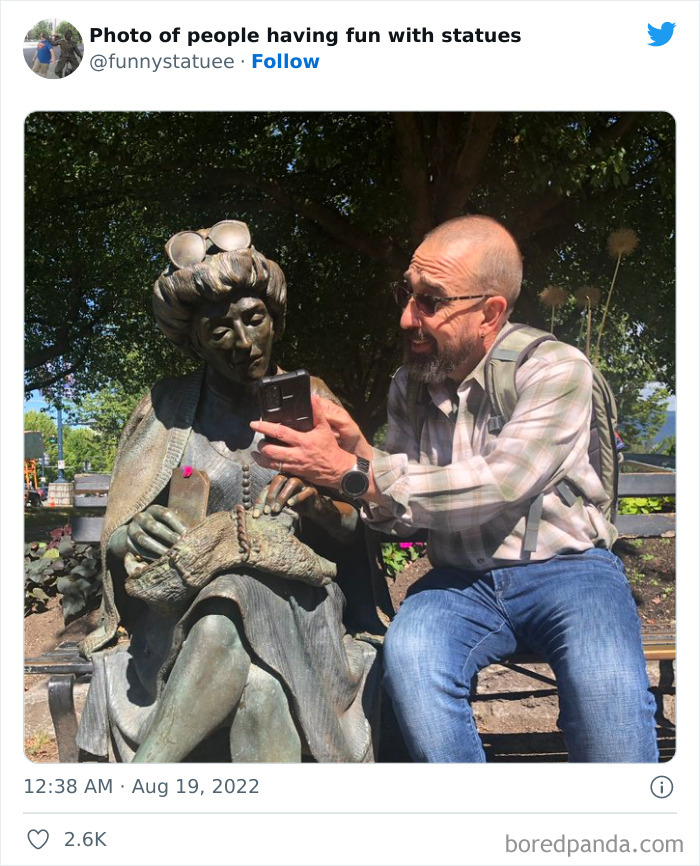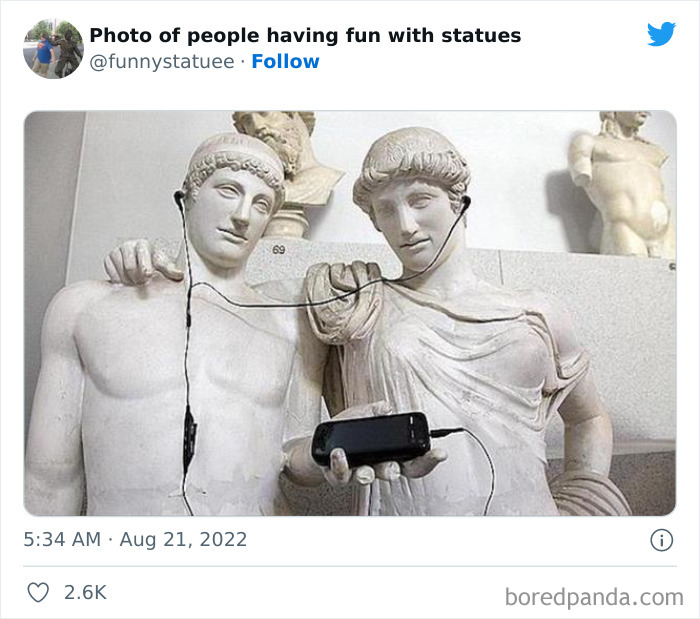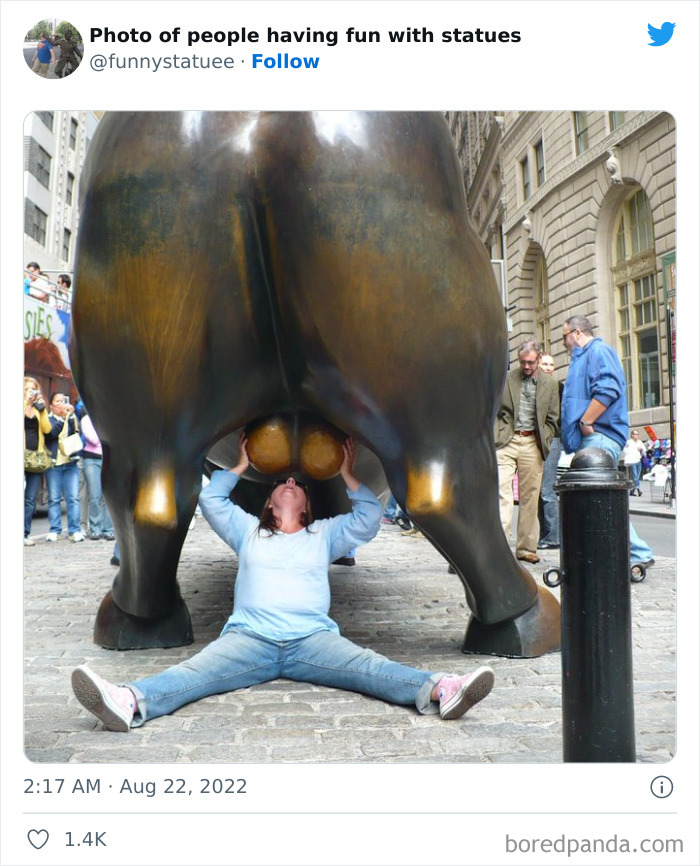From the Statue of Liberty to Christ the Redeemer, there are many sculptures on top of travelers’ bucket lists. Some represent cultural wonders, others mark local heroes and commemorate historical events. They inevitably end up in our holiday photographs, standing tall and straight, as if time stood still for them.
People, however, are not always very serious when it comes to taking a pic with a statue, and some are clearly making entertainment of its own accord. In fact, there’s a whole Twitter page dedicated to people messing around with statues and sculptures called “Funny Statue.”
Below we selected some of the funniest photos they shared, so scroll down and enjoy!
#1
Image credits: funnystatuee
#2
Image credits: funnystatue
#3
Image credits: funnystatuee
It is widely accepted that the Western tradition of sculpture began in Ancient Greece (800BC – 600AD), where sculptors began to move away from creating purely spiritual items towards an attempt to capture the human body in metal and stone. This move had a profound influence on all art that followed, right up until the 20th century. Such classical examples still provide a foundation for the historical canon of art and inform and inspire contemporary artists today.
In the Middle Ages, the driving force for the production of sculpture was Christianity. From altarpieces to reliefs, they represented biblical scenes and what people could expect in the afterlife.
#4
Image credits: funnystatuee
#5
Image credits: funnystatuee
#6
Image credits: funnystatuee
When the Renaissance came, the sculptors were inspired by the study of the human form. Therefore the masters tried their best to represent it in all its glory, merging the idealist and realistic styles. This period was renowned with some of the most famous masterpieces in the history of sculpture with artists like Donatello, Ghiberti and Michelangelo. Some of these masterpieces included Donatello’s bronze David (1430 – 1440), Ghiberti’s Gates of Paradise of the Florence Baptistry (1425) and Michelangelo’s marble Pietà (1498 – 1499) and David (1501 – 1504).
#7
Image credits: funnystatuee
#8
Image credits: funnystatuee
#9
Image credits: funnystatuee
Among the most famous sculptures, there is a little figurine which represents a figure of a naked woman unearthed in the early 20th century. It was assigned the name of the Venus of Willendorf, which represented the fact that it was meant as a fertility sculptural art. What’s incredible about this little piece of history is that it was created around 25,000 BCE, making it one of the planet’s earliest known pieces of art.
#10
Image credits: funnystatuee
#11
Image credits: funnystatuee
#12
Image credits: funnystatuee
Another masterpiece you may have heard of before is the Renaissance sculpture named David created by Michelangelo. The sculpture was initially ordered for the Cathedral of Florence to be placed in the recesses of the cathedral’s tribunes, nearly 80 meters above the ground.
The representatives of the Board commissioned Michelangelo to complete a task initiated by Agostino di Duccio in 1464. In 1501, Michelangelo, only a 26-year-old man, was already the most recognized and well-paid figure of his day.
It’s also said that he was more than happy to embrace the task of sculpting a large-scale David and worked tirelessly for almost two years to produce one of his most magnificent works of shining white marble. Today, you can see David in Bargello National Museum, Florence, so you may want to add this to your bucket list.
#13
Image credits: funnystatuee
#14
Image credits: funnystatue
#15
Image credits: funnystatuee
The last sculpture worth noting is Rodin’s Thinker, which is one of the most iconic sculptures in the world. The large, muscular figure has captivated audiences for decades in his moment of concentrated introspection.
The Thinker was originally called The Poet and was conceived as part of The Gates of Hell, initially a commission (1880) for a pair of bronze doors to a planned museum of decorative arts in Paris. He eventually renamed The Poet to The Thinker and exhibited it on its own in 1888, and then enlarged it in bronze in the early 1900s.
The French government purchased the sculpture and installed it outside the Panthéon in 1906 as a gift to the city of Paris. It was moved to the gardens of the Rodin Museum in 1922, where you can still find it there today.
#16
Image credits: funnystatue
#17
Image credits: funnystatuee
#18
Image credits: funnystatuee
#19
Image credits: funnystatuee
#20
Image credits: funnystatuee
#21
Image credits: funnystatuee
#22
Image credits: funnystatuee
#23
Image credits: funnystatuee
#24
Image credits: funnystatuee
#25
Image credits: funnystatuee
#26
Image credits: funnystatuee
#27
Image credits: funnystatuee
#28
Image credits: funnystatuee
#29
Image credits: funnystatuee
#30
Image credits: funnystatuee
#31
Image credits: funnystatuee
#32
Image credits: funnystatuee
#33
Image credits: funnystatuee
#34
Image credits: funnystatuee
#35
Image credits: funnystatuee
#36
Image credits: funnystatuee
#37
Image credits: funnystatuee
#38
Image credits: funnystatuee
#39
Image credits: funnystatuee
#40
Image credits: funnystatuee
Go to Source
Author: Mindaugas Balčiauskas







































